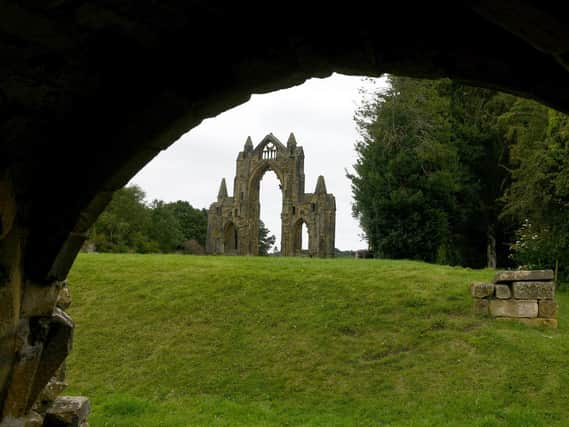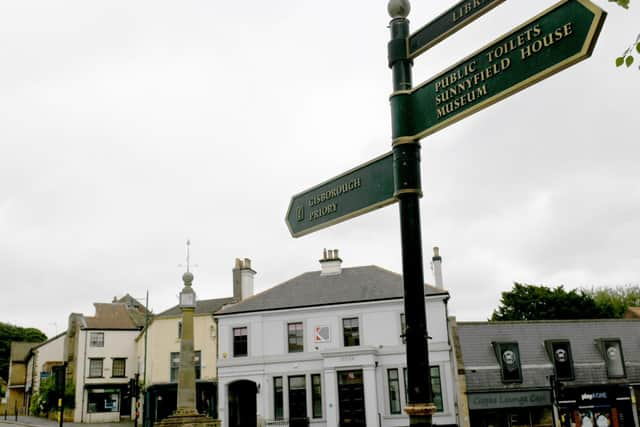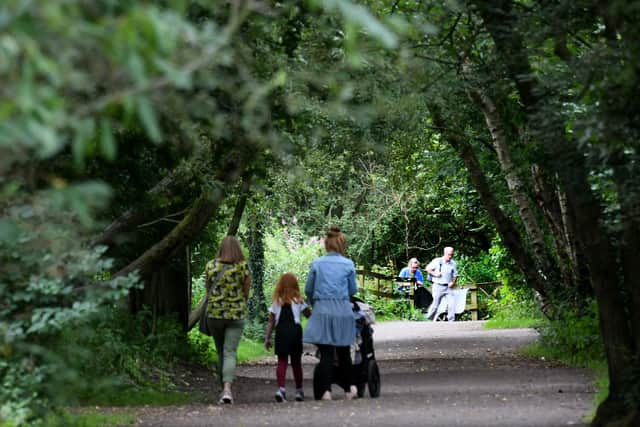North Yorkshire's Guisborough has a sporting and literary tale to tell


For a town of its size, Guisborough has contributed an impressive number of notable athletes, footballers and writers.
Alphabetically speaking, we should start with the remarkable Willie Applegarth, who was born here in 1890, and became a noted track and field runner, winning a Gold Medal in the 4 x 100 metres relay in the 1912 Summer Olympics in Stockholm. Willie was an astonishing record-breaker, and just one of his achievements was to set a world record of 21.2 seconds in the two hundred metres race of the 1914 AAA meeting, and another of 9.8 seconds for the 91 metres race (yes, apparently that was a thing). The latter was to stand until 1958, broken at last in the same year that he died.
Advertisement
Hide AdAdvertisement
Hide AdGrowing up, Willie would have known of a contemporary sportsman, Ralph Gaudie, who played for Guisborough’s South Bank team, Gaudie was a few years older than Applegarth, and by 1897 he was playing for Sheffield United. He transferred to Aston Villa, then to Woolwich Arsenal, where he scored 23 goals in two seasons. Gaudie played his last matches for Manchester United and retired because of ill-health.


Then there was the eminent Victorian cricketer, John Bulmer, a right arm fast medium bowler, who played for his county, and in more recent times Katy Livingston, the Olympic modern pentathlete.
Love of sport hereabouts is apparently nothing new, as an astonishing archeological find proves. In 1864 workers digging some roadworks near the town uncovered what at first sight looked like some rather worse-for-wear headgear. Experts then identified it as the remains of an elaborate helmet, undisturbed for almost 2,000 years, and once the property of a very distinguished Roman. It had belonged to a cavalryman, and it is so richly decorated that it seems likely that it was very much for display purposes, in jousts and tournaments.
There was yet more mystery, for the helmet (which is now in the British Museum) had been very carefully placed in a bed of gravel. Strangely, there are no known Roman sites nearby. Had it been stolen and then hidden? Or did its owner need to bury it because he feared some sort of threat? We shall never know.
Advertisement
Hide AdAdvertisement
Hide AdGuisborough is mentioned in the Domesday Book, but there’s a big debate about whether the name derives from the Norse, or the early Saxon. The second half comes from ‘burh’, which means “place”, or “fortification”, and the first may well refer to a distant ancestor called Gigr. Together, that equates to “Gigr’s Town”. The first building of any note came with the founding of an Augustinian priory in 1119, and it rapidly became one of the richest monastic bases in the whole of England, through donations from the crown and one particular Norman magnate of the time, Robert de Brus. Robert had his fingers in a great many pies, and he was very much involved in granting charters to religious buildings, Durham Cathedral, Whitby Abbey and


Flamborough church among them. At one point, he held the title deed to over 80 manors in Yorkshire alone. And he was also a direct ancestor of the Scots king, Robert the Bruce. He may be (largely) forgotten today, but then ruins of Guisborough Priory are a dramatic reminder of the important part that religion played in the history of communities all over the county – and beyond.
Experts believe that the ruins are among the very best examples of early Gothic architecture in England. On a day with a clear blue sky behind them, they look almost like a stage backdrop – and they have to be among the most-photographed ruins in Yorkshire. Below ground, the vaults, with their ancient rib structure, are also an indication of the skills of the medieval masons. The grounds also boast a charming dovecote.
The local volunteer-run museum (it is best to check on the opening times, but entrance is free) is compact and full of information about the history and heritage of the town and the surrounding countryside, and, apart from all sorts of fascinating artefacts, you will also find the old town’s stocks, They stood for centuries near to the fine Market Cross – so rotting produce was close to hand.
Advertisement
Hide AdAdvertisement
Hide AdAfter the Middle Ages, Guisborough burst back to life as the Industrial Revolution gathered pace – it may sit on the edge of the North York Moors, but those hills were rich in ironstone, and they were heavily mined, and made fortunes for local landowners. One of the most prominent was the businessman Sir Joseph Whitwell Pease. He made his money from his mines, the family bank, wool mills, and he had close links to railway enterprises. For a while, he was Chairman of the North Eastern Railway Company. He was also an MP for nearly 40 years, and he sat as a Justice of the Peace. That may have been the inspiration for a caricature by the noted cartoonist Spy (Leslie Ward) in the society magazine Vanity Fair in 1887. The caption, under the illustration of a smiling gentleman in spats, a frock coat and a top hat merely read “Peace”.
Sir Joseph made enough money to buy himself a country seat, Hutton Hall, which was designed in the gothic style by Alfred Waterhouse. It still stands, and is Grade II listed. Waterhouse also designed the Natural History Museum in London’s Kensington, and the equally imposing Manchester Town Hall. And the icing on the cake for Pease was that he even built a private station to serve the house, his family and his guests on the local branch line. Which he owned.
The station and the Hall both had to be sold when Pease was involved in the collapse of the family bank in 1902. He died, heartbroken, in Falmouth the following year – on his 75th birthday. But his sons soldiered on, and both made names for themselves in British politics.
Other buildings of note are Guisborough’s Town Hall, which is currently being refurbished as a heritage and information centre, and the Jacobean-style Gisbrough Hall, which is also Grade II listed, and today it is an award-winning privately-owned hotel. This stunning building, with its gabled façade, dates from 1856.
Advertisement
Hide AdAdvertisement
Hide AdBut what of those Guisborough writers we mentioned earlier? Well, the earliest is Walter of Guisborough, who flourished in the 14th century, and who was a Canon at the Priory. His Chronicle is a rich source of material for today’s historians.
Henry Savile Clarke was a Victorian writer, critic, librettist, dramatist and journalist. He was the first to produce a stage version of Alice in Wonderland. And then more recently there’s the novelist Richard Milward, and Selina Scott, once one of the stars of TV journalism, who now lives in North Yorkshire as an author, businesswoman (she has a 200-acre farm where she has created a haven for endangered species) environmentalist and campaigner for animal welfare and wildlife conservation.
Perhaps best of all, the town is surrounded by some of the most glorious countryside in all of the county, right next to the Cleveland Way, and in the shadow of the distinctive 320 metres-high Roseberry Topping, celebrated in both literature and song.